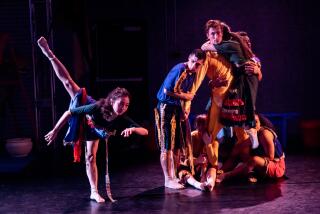AT ROYCE HALL : AMAN FOLK ENSEMBLE RETURNS TO UCLA
- Share via
Call it a comeback. After a period of inactivity reportedly due to a debt crisis and resulting company reorganization, the Aman Folk Ensemble returned to UCLA Sunday with a triumphant reaffirmation of its mastery.
Triumphs are not unusual for Aman, but solvency may be. In any case, the company reflected its new lease on life with a relaxed confidence in its material quite unlike the desperate-to-please spirit evident more than once in the past.
A rich sense of atmosphere pervaded the largely familiar program. The hip-rolling women’s Ghawazee dances from Egypt, for instance, had a casual opulence of movement that, for once, had more to do with sensibility than steps. In the familiar Appalachian finale, convivial warmth and spontaneity replaced the hard-driving showmanship of recent seasons.
And it has been a long time since the music for an Aman performance has seemed so seductive--from the sinuous Egyptian flute solo played by guest artist A. Jihad Racy to the bouncy Cajun (Louisiana) washboard-and-vocal speciality performed by John Zeretzke and Mike McClellan.
Vince Evanchuk’s new suite of Southern Ukrainian dances began simply with a line of 10 men (their arms across each other’s shoulders) in long/loose white blouses, beige vests, plum pantaloons and soft shoes sauntering on stage and encountering two lines of women wearing similar vests plus orange aprons over white skirts.
It quickly (perhaps too quickly) evolved into a large-scale company showpiece, with twisty, high-stepping footwork in the lines and in pairs (each woman positioned at arm’s length to the side of her partner); the women’s line pivoting in big arcs; the men venturing flashy drop-kicks (individually and en masse ); everyone forming a circle and jumping together (legs tucked up)--plus the men leaping over the women’s linked arms straight towards the audience.
Obviously, the bold theatricality of this sequence--the directional focus “out front,” the emphasis on quickly/continually varying steps and spatial patterning, the unison virtuosity--may give an unreliable impression of leisure activities in Hutzul villages. It certainly never suggested the experience of people dancing together for pleasure.
Just as obviously, however, this kind of pared-down, almost kaleidoscopic folk suite engages every kind of dance audience with its unstinting energy, honed technique and quick glimpses of exotic dance forms. Some of us might have preferred a more leisurely survey of Evanchuk’s resources, but there is no denying the broad appeal of his achievement.
Every Aman performance provides its quota of choreographic novelties and the choices on Sunday seemed especially vivid. The celebratory Richard Crum suite from Oas (Northern Romania), for example, featured a chugging, high-speed shuffle-walk, along with spectacular boot-hopping-with-shoulder-shakes: nonstop physical tremors accented by piercing shrieks.
Costumed in black, red and, white, the dancers in Z. Ljevakovic’s suite from Dalmatia (Yugoslavia) had no accompaniment other than the jingling of coins on the women’s costumes, their own brief, periodic singing and the constant stamping footfalls.
Against this spare sound score, the fluid geometry of the dances emerged with special intensity: lines forming into wheels; circles appearing within circles and then breaking into double lines; a line curling into a kind of loop when it flipped its end dancer high into the air. Classify it as folk minimalism, Aman style. And also label it as sensational.
More to Read
The biggest entertainment stories
Get our big stories about Hollywood, film, television, music, arts, culture and more right in your inbox as soon as they publish.
You may occasionally receive promotional content from the Los Angeles Times.










